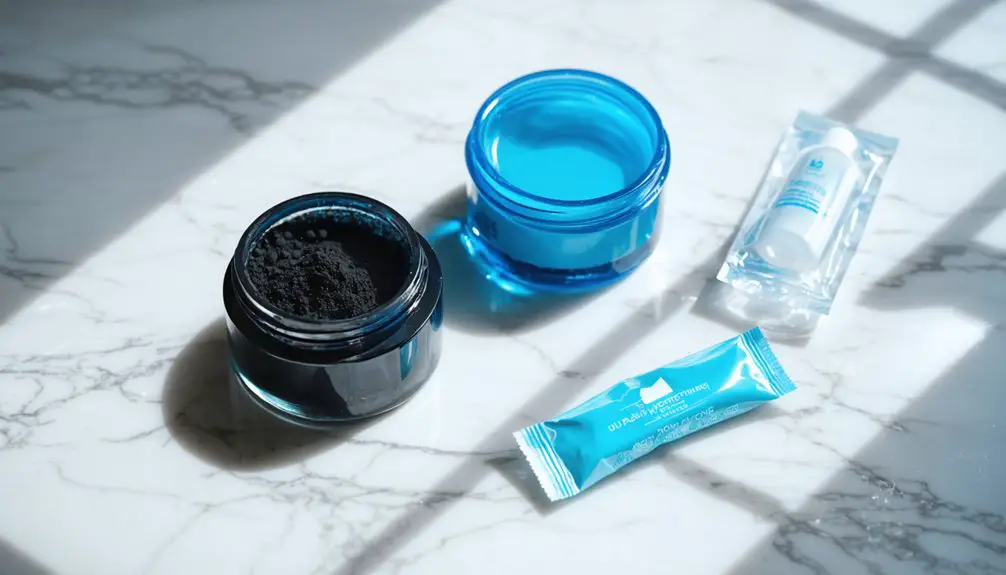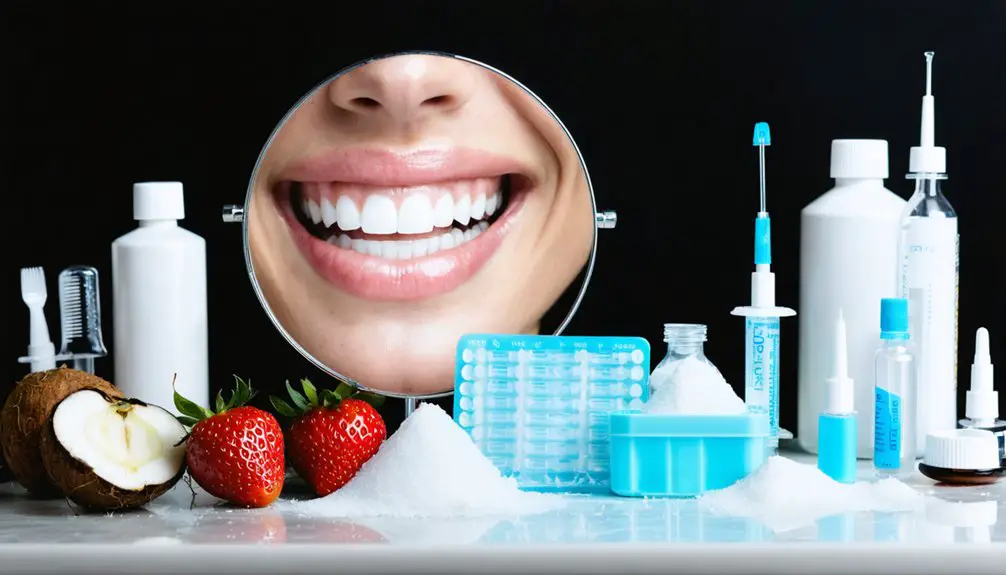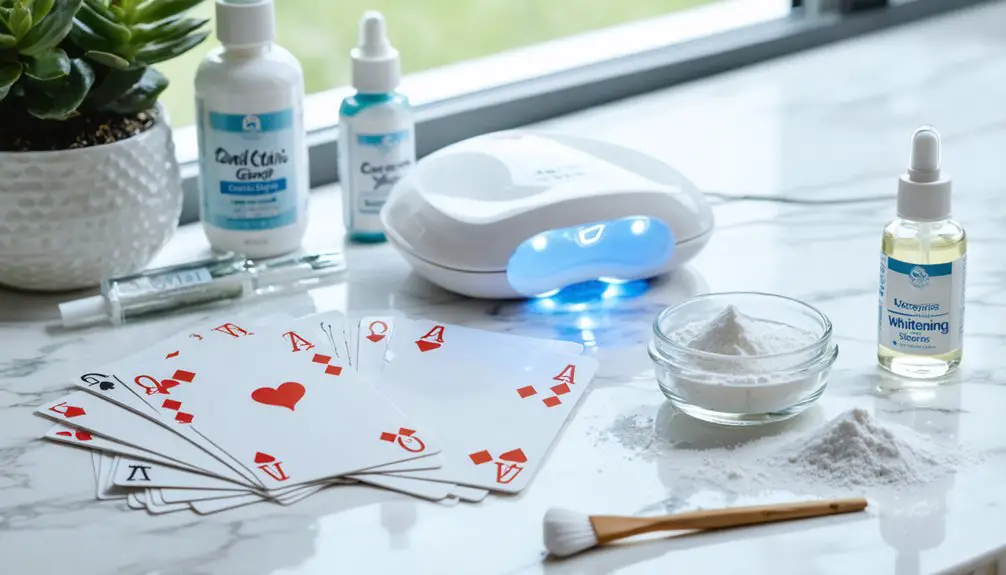You’ll find three proven teeth whitening options at different price points: professional LED treatments ($300-1,500) offering 5-8 shade improvements in 60-90 minutes, ADA-approved at-home whitening kits ($11-45) with peroxide-based formulas, and natural methods using baking soda or activated charcoal solutions. While professional treatments provide fastest results, at-home options balance affordability with effectiveness. Understanding each method’s specifics will help determine your ideal whitening strategy.
Key Takeaways
- Professional LED whitening starts at $275-$660, with options to finance or get package deals at local dental offices.
- At-home whitening kits from local drugstores cost $11-$45 and contain proven ingredients like hydrogen peroxide.
- Natural whitening method using baking soda and hydrogen peroxide creates an effective, affordable paste available from nearby stores.
- Plus White 5 Minute Kit offers quick results with minimal sensitivity and can be found at neighborhood pharmacies.
- Rembrandt 1 Week Whitening Kit provides professional-grade results without sensitivity and is widely available at local retailers.
Professional LED Whitening: A Balance of Cost and Results
While professional LED teeth whitening requires a more significant investment than over-the-counter alternatives, ranging from $300 to $1,500, it delivers superior results under expert supervision.
The cost effectiveness becomes apparent when considering you’ll achieve 5-8 shades of improvement in a single treatment duration of 60-90 minutes.
Basic LED treatments start at $275-$660, while advanced laser-assisted options range from $400-$1,500.
Your results can last 6 months to 3 years with proper maintenance. Dental insurance typically provides no coverage for these cosmetic procedures. Many providers offer financing options and package deals that include pre-treatment cleaning and sensitivity care.
Professional oversight guarantees safe application of high-concentration whitening agents, minimizing risks of enamel damage or gum irritation. Most dental providers use ADA-approved solutions for optimal safety and effectiveness.
You’ll receive customized care based on your specific tooth sensitivity and staining severity.
At-Home Whitening Kits That Won’t Break the Bank
Although professional treatments deliver rapid results, affordable at-home whitening kits offer a cost-effective alternative, with options ranging from $11 to $45.
You’ll find proven whitening ingredients like hydrogen peroxide and carbamide peroxide in products such as Crest 3D White Whitestrips Professional Effects Kit, which effectively penetrates enamel to lift stains.
For sensitive teeth, consider peroxide-free alternatives containing natural whitening ingredients, though results may take longer. The Rembrandt 1 Week Whitening Kit showed no tooth sensitivity during testing.
LED whitening systems can provide enhanced whitening results when combined with peroxide gels in as little as one week.
User experiences highlight Plus White 5 Minute Kit’s minimal sensitivity and easy tray application.
When selecting a kit, prioritize those with the ADA Seal of Acceptance, which verifies safety and efficacy.
Remember to follow application instructions precisely, as overuse can cause irritation.
Custom-fitted trays, like those from Smile Brilliant, provide ideal contact time and more consistent results.
Natural and Budget-Friendly Teeth Brightening Methods
Beyond commercial whitening kits, natural and cost-effective methods offer viable alternatives for teeth brightening.
You’ll find baking soda particularly effective as a mild abrasive that removes surface stains while neutralizing harmful acids in your mouth. While activated charcoal demonstrates slightly superior whitening properties, it requires cautious application due to potential enamel wear risks. Professional treatments typically require four short visits to achieve optimal results.
Mixing baking soda with hydrogen peroxide solution creates an effective whitening paste that can be used twice daily for one week.
Avoid using acidic substances like lemon juice or orange peels directly on teeth, as these can permanently damage your enamel.
Instead, focus on preventive measures: rinse thoroughly after consuming staining beverages, maintain consistent oral hygiene, and consider oil pulling as a supplementary practice.
While oil pulling lacks strong scientific validation for whitening, it’s generally safe when combined with regular dental care.
Frequently Asked Questions
Can I Whiten My Teeth if I Have Dental Crowns or Veneers?
While you can whiten natural teeth, crown whitening and veneer maintenance require different approaches since restorations won’t respond to bleaching agents. Consider consulting your dentist to avoid potential shade mismatches.
How Long Should I Wait to Whiten Teeth After Dental Work?
You’ll need to wait 2-8 weeks after dental work to avoid teeth sensitivity issues. Recovery time varies: 2 weeks for fillings, 4-8 weeks for gum surgery, and 14 days for crown adhesives.
Is Teeth Whitening Safe During Pregnancy or While Breastfeeding?
You shouldn’t undergo teeth whitening during pregnancy or breastfeeding due to insufficient safety data. While no studies confirm harm, dental professionals recommend waiting until after nursing to avoid potential chemical exposure.
Will Whitening Treatments Affect the Bonding Material Used for Fillings?
Your bonding materials won’t whiten with bleaching treatments since they’re nonporous. Whitening effects only work on natural tooth enamel, potentially creating color mismatches between your natural teeth and existing fillings.
Can Medications or Medical Conditions Interfere With Teeth Whitening Results?
While whitening can still work, your medication effects and health conditions might reduce results. Antibiotics like tetracycline, blood pressure drugs, and conditions affecting enamel structure can limit whitening’s effectiveness.
References
- https://www.goodhousekeeping.com/health-products/g28723133/best-at-home-teeth-whitening-products/
- https://nhdentistrybeverlyhills.com/press/6-of-the-best-teeth-whitening-kits-in-the-drugstore/
- https://www.lakeviewmoderndentistry.com/post/affordable-teeth-whitening
- https://lanedds.com/?p=26079
- https://kaufmandentistry.com/2025/04/10/which-at-home-whitening-treatments-are-worth-it/
- https://www.thesmiledesign.com/blog/teeth-whitening-cost/
- https://www.trysnow.com/blogs/news/how-much-does-teeth-whitening-cost
- https://thegleamery.com/blogs/fresh-facts/how-much-does-professional-teeth-whitening-cost
- https://www.gentledental.com/resources/articles/teeth-whitening-cost
- https://www.parksmilesnyc.com/how-much-does-teeth-whitening-cost-in-manhattan/



